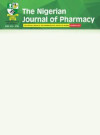Evaluation of Citrus sinensis (Osbeck) (Rutaceae) Peel Preparation on The Reduction of Creatinine Levels and Its Antioxidant Properties In-Vitro
Abstract
Background: The incidence of kidney diseases is on the increase globally, which necessitate the need for a safer alternative that will mitigate the effect of kidney disease. The study assessed the ability of Citrus sinensis peel extracts to reduce creatinine, a significant biomarker for glomerular filtration rate, a test that measures overall efficiency of the kidney.
Method: Citrus sinensis peels were collected, identified and authenticated by a curator. Phytochemical screening was carried out using standard procedures Antioxidant activity was determined using 1,1-diphenyI-2-picryIhydrazyI (DPPH) radical scavenging assay compared to Vitamin E standard. All experiments were carried out in triplicates. Two-way analysis of variance (ANOVA) was used to compare the difference between the antioxidant activities of extracts and standard drugs at 95% confidence. Amount of creatinine was determined using the Jaffe method before and after the addition of the extract to determine the effect of the extract on the amount of creatinine in the urine samples. The creatinine calculated to be present was analysed statistically using STATA MP 16.
Results: Extract was rich in saponins, terpenoids, tannins, flavonoids, reducing sugars and unsaturated lactone. The fresh peel extract at a concentration of 1% exhibited a DPPH antioxidant activity of 89.44% 1 0.3 and the dried peel extract at a concentration of 1% indicated a DPPH antioxidant activity of 79.16% + 1.03 compared to the Vitamin E standard used. The extract showed statistically inferior antioxidant activities compared to the standard drug across all concentrations (p<0.05). The significant Creatinine reduction observed for the fresh peel extract was 0.001, 0.005 and 0.173 for the morning, afternoon and evening urine samples, respectively. The significant Creatinine reduction observed for the dried peel extract was 0.008, 0.034 and 0.085 for the morning afternoon and evening urine samples, respectively. Insignificant differences of 0.604, 0.626 and 0.331 were gotten upon comparison of the two extracts which indicated that both the extracts are equally as effective in Creatinine level reduction.
Conclusion: From the study carried out, the extracts were rich in secondary metabolites, the extracts had compared with Vitamin E, and the extracts had, to a certain degree the ability to reduce creatinine levels.
References
Onopiuk, A., Tokarzewicz, A., & Gorodkiewicz, E. (2015). Cystatin C: a kidney function biomarker. In Advances in clinical chemistry (Vol. 68, pp. 57-69). Elsevier.
Traynor. V, Charles. S (2006) Urea and Creatinine Importance. Cellular Biochemistry,-3(3) 45-50.
Wasung M.E, Chawla L.S, Madero M (2015) Biomarkers of renal function, which and when. Clin Ch/m Acto,-7(1): 350- 480.
Gounden V, Bhatt H, Jialal I. Renal Function Tests. 2020). In: StatPearls [Internet]. Treasure Island (FL): StatPearls Publishing; [Updated 2020 Jul 20]. Available from: https://www.ncbi.nlm.nih.gov/book s/NBK507821/ cited (26/10/2020)
Lesley A. Stevens, M.D., Josef Coresh, M.D., Ph.D., Tom Greene, Ph.D., and Andrew S. Levey, MD (2006) Assessing Kidney Function — Measured and Estimated Glomerular Filtration Rate. N Engl J Med,- 354:2473-2483.
Egbi, 0. G., Okafor, U. H., Miebodei, K. E., Kasia, B. E., Kunle- Olowu, 0. E., & Unuigbe, E. I. (2014). Prevalence and correlates of chronic kidney disease among civil servants in Bayelsa state, Nigeria. Nigerian Journal of clinical practice, 17 (5), 602—607.
Armington .T, Carmada .L., Di Stefano, V., Del Bosco, S. and Schillaci, D. (2007). Antiproliferative activity of Citrus juices and HPLC evaluation of their flavonoid Composition. Fitoterapia;78(6):426- 429.
Tripoli Elisa, Maurizio, Giammanco Danila (2007). Citrus flavonoids: Molecular structure, biological activity and nutritional properties: A review. Food ChemiStr/;104 (2):466-479.
Khalil, M. I., Sulaiman, S. A., & Boukraa, L. (2010). Antioxidant properties of honey and its role in preventing health disorder. The Open Nutraceuticals Journal, 3[1).
Ayoola, G. A., Coker, H. A., Adesegun, S. A., Adepoju-Bello, A. A., Obaweya, K., Ezennia, E. C., & Atangbayila, T. 0. (2008). Phytochemical screening and antioxidant activities of some selected medicinal plants used for malaria therapy in Southwestern Nigeria. Tropical Journal of Pharmaceutical Research, 7(3),1019-1024.
Blois, M.S. (1958)Antioxidant determinations by the use of a stable free radical. Nature,- 181(2):99-120.
Eruygur, N., Atau, M., gevik, 0 and Tekin, M. (2017). Investigating of Phytochemicals, Antioxidant, Antimicrobial and Proliferative Properties of Different Extracts of ThyfTtUS S[ athulifolius. International Journal of secondary Metabolites,4[3): 155-166.
Salazar, J.H. (2014). Overview of urea and creatinine. Laboratory Medicine, 45(1), e19- e20.
Joris R. Delanghe, Marijn M. Speeckaert (2011).Creatinine Determination According to Jaffe—What Does It Stand For? NDT Plus; 4 (2): 83—86.
Talalak, K., Noiphung, J., Songjaroen, T., Chailapakul, 0., & Laiwattanapaisal, W. (2015). A facile low-cost enzymatic paper-based assay for the determination of urine creatinine. Talanta, 144, 915-921.

Published
How to Cite
Issue
Section
License

This work is licensed under a Creative Commons Attribution-NonCommercial 4.0 International License.


